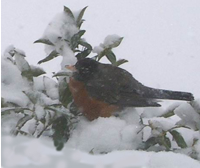How Do Robins Keep Warm in Winter?
Article | Journal Page
This
robin is in a blizzard. The wind is blowing 35 mph and gusting to 70
mph! The blizzard will last for 24 hours. The night temperature will
drop to 6° F. Brrrr! How can robins survive such weather?
Seeking Shelter
During storms, birds try
to get as sheltered as they can. Like this robin, they take shelter
in bushes, near buildings, or in trees. (Nests are not
shelters, but only cradles for baby robins.)
Staying Dry
A robin preens its long, outer contour feathers to keep them clean, oiled and waterproof. Rain slides off. Snow doesn’t melt on cold feathers,
so the feathers stay dry.
Fluffing Feathers
What do you notice about the robin's feathers?
The bird fluffed up his feathers to increase the amount of air next to the body for more protection from the cold.
The long outer feathers overlap and hide a dense layer of loose down feathers closer to the skin. The down feathers trap air, an excellent insulator. Puffed-out feathers insulate the bird’s internal
organs so they stay at 104° F. The outside of the feather is cold, like
the air. But, just a few millimeters under the feathers, the bird's
body temperature is a cozy 104°F. Multiple layers of feathers are the world's best insulators!
Consuming Calories
Foraging and eating are the main winter activities of birds that stay in the colder north. Their sharp eyes find shriveled berries left on trees and bushes. Their beaks poke in leaf litter to find any insects. When fruit starts getting scarce, robins usually leave. They don’t want to be stuck during a storm in a place where there’s no fruit left. Robins do most of their wandering on nice days as they travel to find good food sources.
What About the Feet?
Even when standing in snow, a robin's feet don't get cold. Their circulation is so fast that the blood doesn't have time to chill. Thanks to the design of a robin's blood vessels, cooler blood shooting up the toes and legs is heated by warmed blood flowing back from the bird's heart. The exposed part of a bird’s legs and feet don’t have muscles that require a lot of blood
flow to work them. The feet open and close by tendons rather than muscles, which need more blood to power them.
Still, birds fluff their belly feathers to help cover the toes and keep them warm. Robins are well designed for all weather!
| Seeking Shelter |
| Kim Smith |
 |
| Staying Dry |
| Suzanne M. |
 |
| Fluffing Feathers |
| Randy Indish |
 |
| Consuming Calories |
| Donald Severson |
 |
| Adapted for Cold |
| Kim Smith |



